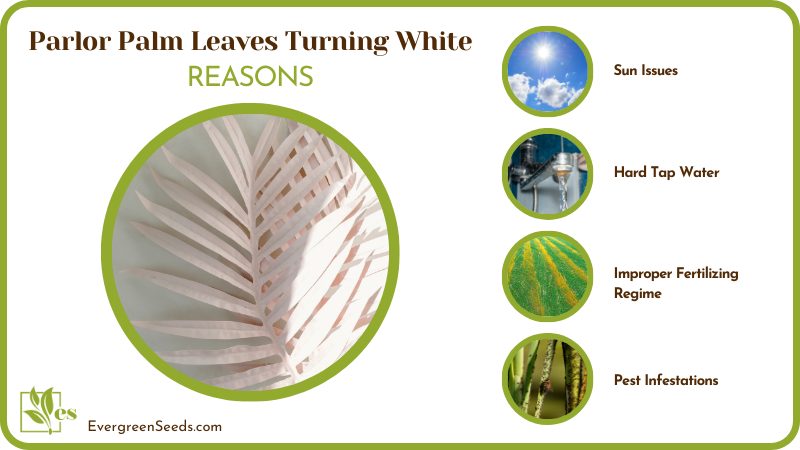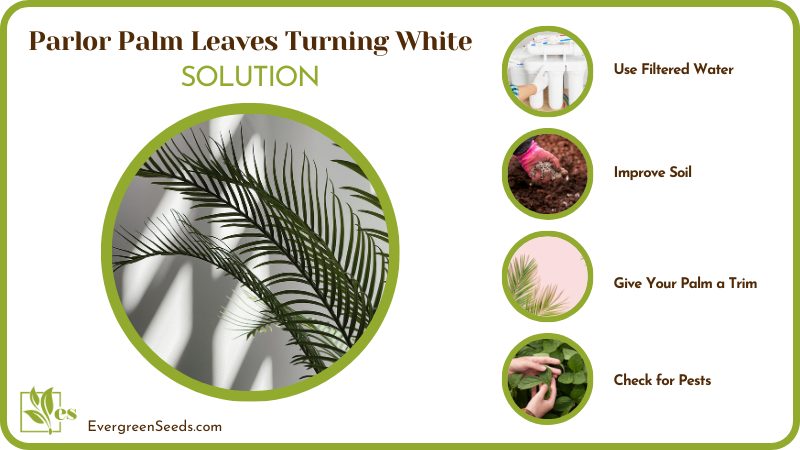Parlor palm trees turning white is the most common reaction when our palms are accidentally exposed to full sun. However, the issues go well beyond a mere light exposure.
These beloved indoor palms can react badly and turn white due to some other reasons. Let’s discover what they are and find out how to prevent and heal our beloved beauties.
JUMP TO TOPIC
Why Is The Parlor Palm Turning White?
The parlor palm is turning white because of excessive sunlight, pest infestation, or a buildup of lime or calcium from hard tap water. In addition to these, it can also be because of the disease known as graphiola leaf spot, or improper fertilizing regime.
In their natural habitat, the palm, which is also known as Neanthe Bella palms, would be basking in filtered sunlight, rarely encountering the intensity of the direct sun. When your parlor palm’s fronds turn white, it’s a telltale sign of leaf sun scald.
With minimal defense against direct sunlight, the outer layers of tissue succumb to burns, revealing a white discoloration on the leaves and stem. If you’ve recently experienced a sunny spell or relocated your palm to a window with full sun exposure, this is likely the cause of its whitening phenomenon.
– Sun Issues
When the plant is exposed to sunlight in different ways, the matter becomes one of the key parlor palm problems. You may think these love full sun, but they thrive in shadier environments, like the forest floor, and will struggle if exposed to direct light.
If the leaves bleach when turning white, it’s a sign of sunburn caused by intense sunlight, and this is before it turns crispy. Typically, sunburn affects the tips closest to the window, so that’s another way to spot this issue.
Consistently subjecting your plant to burns is not recommended, as it causes stress, stunts parlor palm growth, and leads to the plant being unhappy. This matter would also take place in winter if your plant is placed in a location that would also have very bright light coming directly towards it.
– Hard Tap Water
Your parlor palm might be sporting a snowy white look due to lime or calcium build-ups caused by watering with hard tap water. These build-ups can grow larger, transforming entire leaves into a pure white shade, and due to the salt content or the number of minerals that are abundantly present in the water, this matter would be seen.
While not harmful, it’s still very much unappealing to the eye. In addition to this Drainage can become an issue too! Beware of waterlogged potting soil around your parlor palm tree, as it can lead to the dreaded root rot. Despite their tropical nature, these trees don’t appreciate having their feet soaked. Ensure proper drainage to keep your tree happy and thriving.
– Improper Fertilizing Regime
Neglecting to provide your palm tree with the proper nutrients can also result in the unwelcome transformation of its leaves. However, giving your trees too much will really cause them to move into a paler shade of white. This happens due to mineral buildup in the roots, and if the palm receives too much, the remaining feed could also crystallize in the foliage!
One crucial nutrient for parlor palms is potassium, which is vital to their health. It is imperative to employ a fertilizer explicitly formulated for these trees, boasting a generous potassium content. By ensuring your parlor palm receives the appropriate nourishment, you can safeguard its leaf coloration and or else it will begin to look faded in color and quality that the plant’s leaves have.
– Pest Infestations
Your parlor palm’s white appearance may be a result of an infestation of bugs. Among the common pests in the plant world, spider mites are notorious invaders of parlor palms, leaving their intricate webs beneath the leaves.
Typically, the infestation must be severe to impact the leaf color, prompting the need for action, and this matter would often take months. Spider mites are minuscule, often invisible to the naked eye. If you suspect their presence, take your palm outside and give it an intense wash with a garden hose.
While insecticides can be used against mites, they may not always be necessary. This is why another potential threat to parlor palms is mealybugs. These fluffy, white pests can also cause leaf discoloration when they inflict substantial damage or if the population becomes too huge to handle, so you would see the leaves going from their vibrant green color to lighter shades and also white.
– Graphiola Leaf Spot
One particular whitening suspect from the disease realm to watch out for is Graphiola leaf spot, a fungal disease that specifically targets parlor palms, regardless of their species. The insidious nature of this disease begins with the appearance of black spots on the undersides of the leaves, gradually spreading its influence throughout the entire tree.
Parlor palms naturally resist this affliction, often experiencing minimal damage as they confine the disease to a localized area. Nevertheless, the leaves will take on a white shade too. For those devoted to nurturing their green companions with the utmost care, promptly addressing any signs of a fungal infestation is advisable.
How To Avoid The Transformation of Parlor Palm Leaves into White?
To avoid parlor palm leaves turning white, you should give your trees some shade and avoid sunburns, you must also use filtered water, and make sure to improve the soil’s quality. Try to give your plant a trim, and ensure to check for pests often.
– Give Your Trees Some Shade
Aim for a spot that is brightly lit but shielded from direct sunlight, and watch your palm flourish with gratitude. These are the types of palms that are labeled as a plant that loves low light, but it doesn’t mean you must deprive them of light, or the brightest rays of light should be coming upon them at all times.
If your palm still receives prolonged direct sunlight, consider relocating it or using a sheer curtain to shade the window during those high noon hours, so that it would come in an indirect way. These plants thrive in bright, filtered light but adapt well to low-light conditions. So, show your palm affectionately by providing it with gentle, filtered light.
We already mentioned curtains, but keeping them away from your window will also do the trick. If you feel like treating your palm to a change of scenery, you can take it outdoors when the weather is warm. Just remember to find a spot where it won’t receive direct sunlight, as this can lead to leaf scorching.
– Use Filtered Water
As hard water is not the best type for the leaves of your plant, due to the abundance of minerals, you must consider using softer water, and for this you can always opt to collect some rainwater as a means to become more sustainable in the process. Beware of giving your palms too much, and this poses a greater risk to your plants than the water quality. Indoor plants, including the magnificent Parlor Palm, detest soggy soil.
To ensure its flourishing existence, water your palm thoroughly and then allow it to experience a slight drying period. Overwatering leads to prolonged soil saturation, inviting the rot to wreak havoc and potentially claim the life of your beloved tree.
During the winter months, reduce the frequency of watering as the drying process takes longer. Remember, plants have their unique ways of communicating their needs. This type of plam tree reveals its longing through brown leaf tips, indicating overwatering, while fronds turning yellow serve as a plea for a little more hydration.
– Improve Soil
The soil surrounding your tree must possess impeccable drainage to ward off the fearsome rot. If you suspect that poor drainage is the problem, there are effective remedies to combat this menace. Moreover, it can also be one that has a great number of minerals from the water that you use, and over the years, the soil may also become hardened.
Enhance the soil’s drainage capabilities by incorporating inorganic matter, which works wonders in facilitating proper water flow. Lava rocks, pebbles, and other rocky planting soil will often suffice when it comes to drainage and airflow of the bottom parts of the tree. Additionally, if you’re growing the palm outside, you can always have it strategically planted in an area with excellent natural drainage.
– Give Your Palm a Trim
Regularly inspect your palm’s leaves to detect the presence of this fungus, as it can potentially open the door for other fungal issues to infiltrate the plant’s system. Embrace the simplicity of pruning, allowing your Parlour Palm plant to thrive and captivate with its rejuvenated appearance.
These palm trees, are masters of self-cleaning, and you would also see that their aged fronds gracefully transition into rich brown tips and white spots before effortlessly detaching from the plant, no intervention required. Nevertheless, if you desire to maintain a picture of impeccable health, an occasional trim can work wonders, and make sure to get rid of it.
Try to go ahead with the pruning process with a pair of sharp scissors; selectively remove only the brown and yellow parlor palm leaves as soon as they emerge. This practice allows the plant to invest its energy in sprouting fresh, vibrant growth, and you won’t see the plant stressing anymore.
– Check for Pests and Tackle Them
To keep pesky pests and diseases at bay, adopt a vigilant approach and conduct regular inspections of your parlor tree. Swift action is key when spotting any signs of infestation or disease. The mighty power of water jets can work wonders in dislodging mites, so you must ensure you thoroughly wash the palm leaves’ top and underside, reaching every nook and cranny of the fern’s stems.
While resorting to insecticides may not be necessary, they can be employed if natural methods fail to control the infestation. However, be cautious with alcohol application, as parlor palms may not take kindly to it.
Usually, a couple of treatments with a powerful hose will suffice to restore the plant’s health and vibrant green hue. Remember to trim off dead leaves, allow new growth to flourish, and stay alert for signs of lingering pests, ensuring your parlor palm remains a haven of green tranquility.












